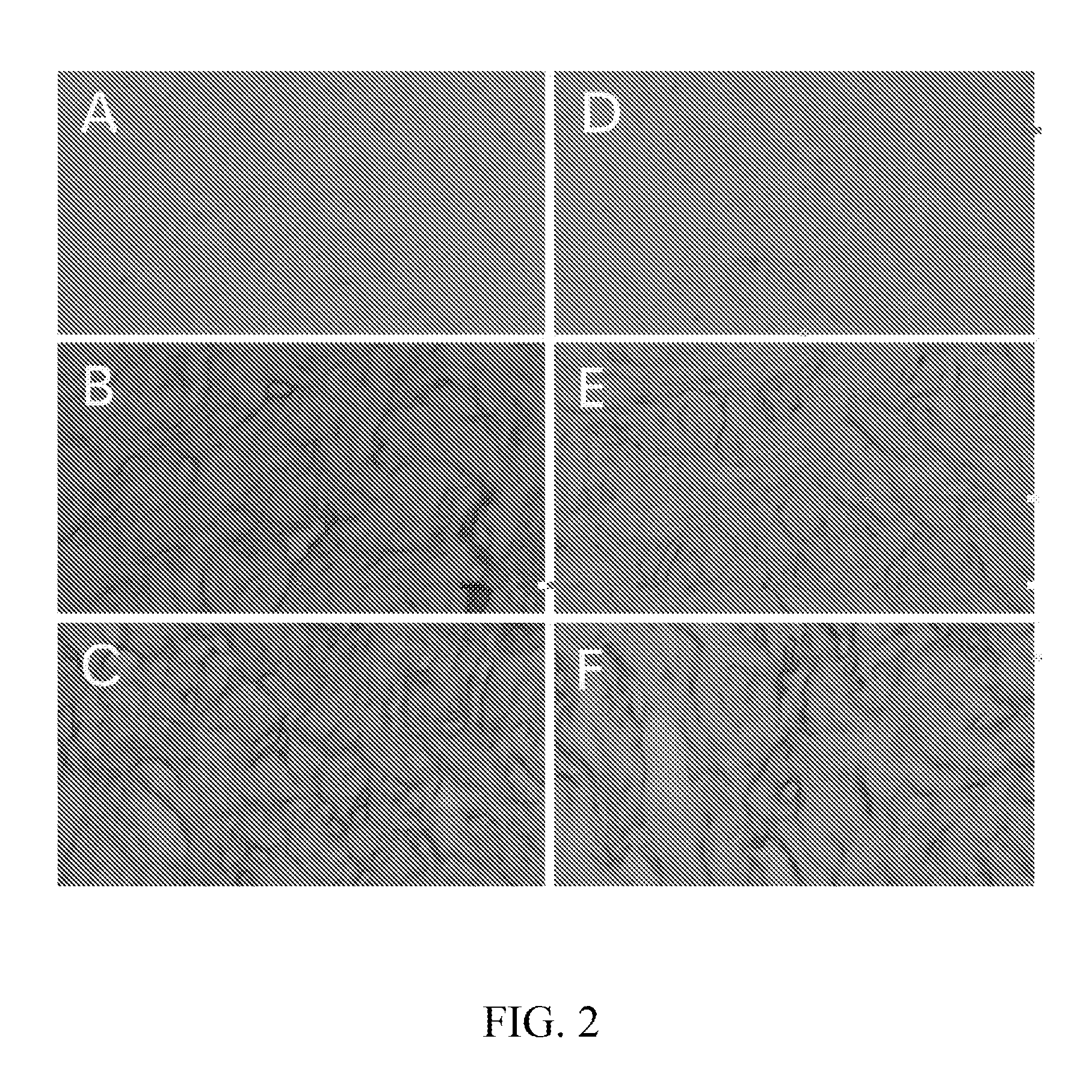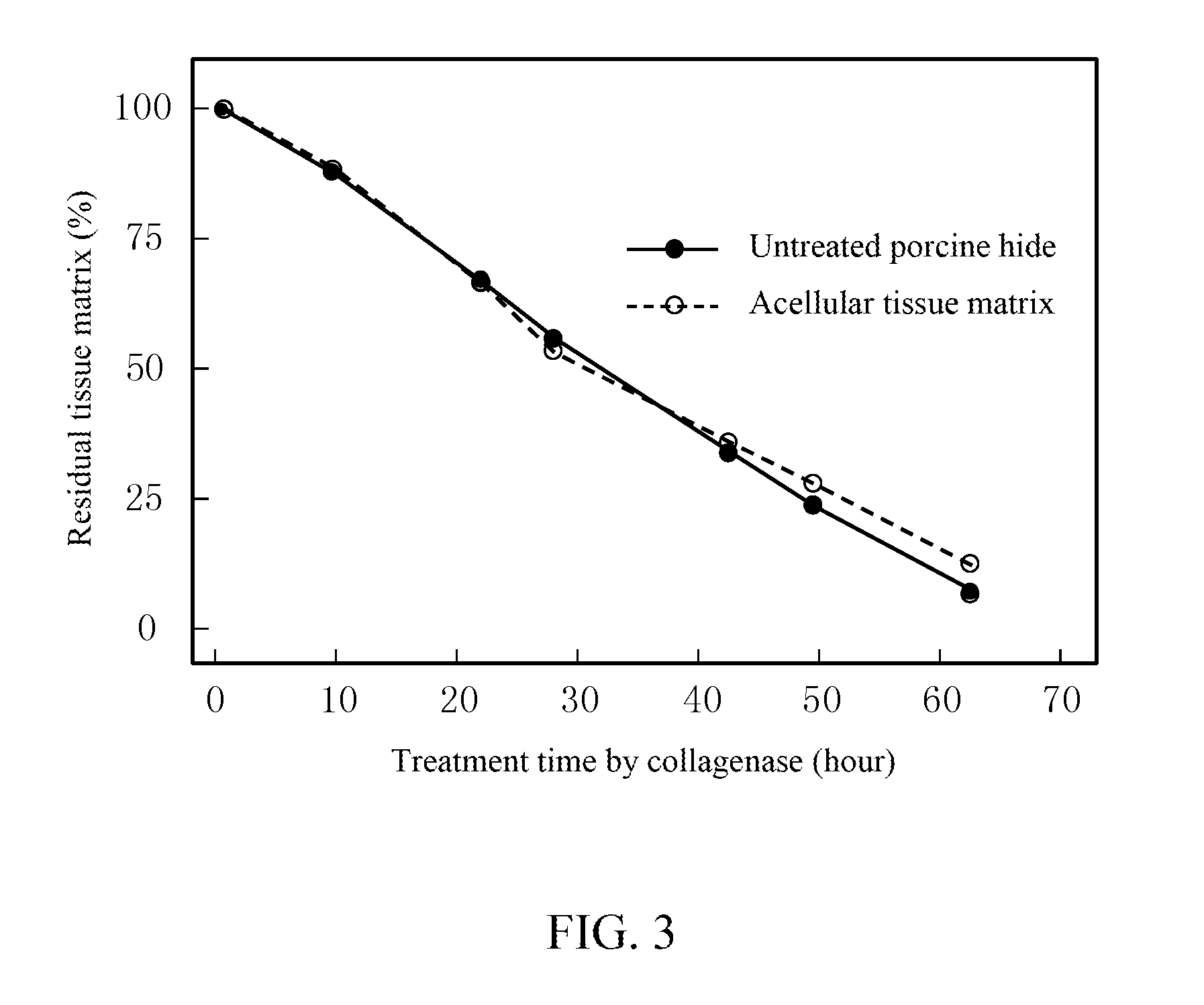Method for preparing an animal decellularized tissue matrix material and a decellularized tissue matrix material prepared thereby
a tissue matrix material and decellularized technology, applied in the field of biological tissue treatment and the manufacture of tissue matrix materials, can solve the problems of tissue matrix prone to torn when used, complex process procedure for tissue matrix and organ manufacturing, and insufficient physical method to achieve complete decellularization
- Summary
- Abstract
- Description
- Claims
- Application Information
AI Technical Summary
Benefits of technology
Problems solved by technology
Method used
Image
Examples
example 1
Manufacture And Performance Detection of an Animal Acellular Tissue Matrix Material
[0055]1. Manufacture
[0056](1) Collection and Preservation of a Tissue and Organ
[0057]Fresh porcine hide was collected from a newly slaughtered pig, and temporarily preserved in a refrigerator at 4° C. After the porcine hide was dehaired mechanically, the porcine hide was split into a dermis layer having a thickness of about 1.0 mm, which was cryopreserved at −20° C.
[0058](2) Decellularization
[0059]After the dermis was thawed, it was firstly flushed with a normal saline twice, each time for 30 minutes. The flushed porcine dermis was soaked in a saline solution containing 100 mg of gentamicin per litre, and 2.0 millimole concentration of calcium chloride, 2.0 millimole concentration of magnesium chloride, and 150 units per litre of neutral dispase were further added to the solution, and the dermis is treated at 37° C. for 24 hours.
[0060](3) Washing
[0061]After being soaked in gentamicin, the dermis was w...
example 2
Determination of Appropriate Conditions for Washing and Disinfecting the Dermis
[0070]Fresh dermis was collected from a porcine body, and the fresh porcine dermis was treated in sodium hydroxide solutions with pH of 10.6, 11.5 and 11.8 at 37° C., respectively. Each kilogram of the porcine hide was in 4 litre of sodium hydroxide solution, with the control of phosphate buffer. After 24 hours, colony-forming unit per milliliter solution was determined. The phosphate buffer contained 10.3±1.3 logarithmic colony-forming unit (LogCFU)(N=3); and the logarithmic colony-forming unit in the solution with pH of 10.6, 11.5 and 11.8 was 2.1±0.1, 0 and 0, respectively. As could be seen, disinfection and sterilization effect in moderate alkaline solution was significant. It was demonstrated by using differential scanning calorimeter that the tissue matrix was damaged with pH of 11.5 or more, and the stability of protein in the tissue matrix was significantly reduced. The damage of high pH on the ti...
example 3
Manufacture and Performance Detection of an Animal Acellular Tissue Matrix Material
[0071]1. Manufacture
[0072](1) Collection and Preservation of a Tissue and Organ
[0073]Fresh porcine hide was collected from a newly slaughtered pig, and temporarily preserved in a refrigerator at 4° C. After the porcine hide was dehaired mechanically, the porcine hide was split into a dermis layer having a thickness of about 1.0 mm.
[0074](2) Collection and Washing
[0075]After collection and washing (see example 1), the porcine dermis with a thickness of 1.0 mm was temporarily preserved in a refrigerator at −80° C.
[0076](3) Decellularization
[0077]After being thawed, the dermis was flushed with 5 mM of hydroxyethylpiperazine ethane sulfonic acid solution (pH 7.4), and was then treated at 37° C. for 18 hours after adding 2.0 mM of calcium chloride and 0.2 unit per milliliter of neutral dispase.
[0078](4) Washing
[0079]The dermis was washed with 1.0% sodium deoxycholate solution at 37° C. for 20 hours.
[0080](...
PUM
| Property | Measurement | Unit |
|---|---|---|
| Temperature | aaaaa | aaaaa |
| Temperature | aaaaa | aaaaa |
| Temperature | aaaaa | aaaaa |
Abstract
Description
Claims
Application Information
 Login to View More
Login to View More - R&D
- Intellectual Property
- Life Sciences
- Materials
- Tech Scout
- Unparalleled Data Quality
- Higher Quality Content
- 60% Fewer Hallucinations
Browse by: Latest US Patents, China's latest patents, Technical Efficacy Thesaurus, Application Domain, Technology Topic, Popular Technical Reports.
© 2025 PatSnap. All rights reserved.Legal|Privacy policy|Modern Slavery Act Transparency Statement|Sitemap|About US| Contact US: help@patsnap.com



